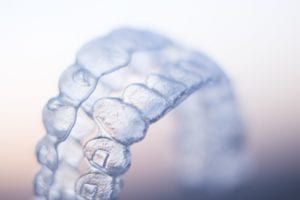What Are Invisalign Attachments?

If you are considering orthodontic treatment to correct crooked teeth and a misaligned bite, then you have most likely heard of Invisalign. In fact, many people choose Invisalign when undergoing orthodontic treatment because of its discreet appearance and minimally-invasive approach. Despite its different method, Invisalign is still able to produce comparable results to traditional wire braces. For all these reasons, Invisalign has become one of the most popular orthodontic treatments.

While many people are familiar with the clear aligners that have helped to make Invisalign so popular, not as many people are familiar with Invisalign attachments. Formally named SmartForce Attachments, they are the unrecognized heroes of Invisalign treatment. In fact, these attachments are what aid in complex tooth movements to obtain the desired orthodontic results.
In order to understand the importance of these attachments, we must first look at the basics of how orthodontics work. To move the teeth, orthodontic treatment uses constant pressure to gradually reposition the teeth. This pressure can cause the teeth to shift in position, move up and down, or rotate. With traditional metal braces, this is accomplished with the use of metal brackets and an archwire. When tightened, the archwire applies pressure to the brackets, which cause the teeth to move.
Since Invisalign does not use metal brackets or wires, its method is a little different. Instead, Invisalign utilizes a clear aligner to exert pressure on the teeth in order to move them. However, there are some cases where an aligner alone is not enough to get the right type or degree of movement. In these cases, Invisalign attachments can be placed to encourage more movement.
Invisalign attachments make your aligners fit snugly by acting as anchors in order to help the aligners apply the right type of pressure to move the teeth more easily. They are usually placed in the middle of the tooth to ensure the aligner is on properly and applying pressure in the right places. Invisalign attachments are easily applied to your teeth using dental bonding and will later be removed by being buffed off. The attachments are made from tooth-colored composite resin and can be circular, square, rectangular, or triangular in shape, depending on the desired results.
Depending on your individual case and treatment plan, your orthodontist will decide how many Invisalign attachments need to be placed. In most cases, only some teeth will need to have attachments placed to obtain the desired results. In most cases if Invisalign attachments are required, they will be left in place for the duration of your treatment.
Invisalign attachments are not removable like the aligners, but they usually don’t cause many problems. Your aligners will still be able to be removed for eating, drinking, brushing, and flossing. Some people note that the attachments can irritate the inside of their mouth when their aligners are not in place, but this discomfort is generally minimal and can easily be remedied by simply wearing your aligners.
Overall Invisalign attachments are tooth-colored composite shapes that are placed to help the aligners move teeth better. They are ideal for more complex cases that may require additional force to obtain the desired results. Like the rest of the Invisalign method, these attachments are also discreet and minimally-invasive to make orthodontic treatment as pleasurable as possible.

Dr. Massih attended UCLA, where she graduated Magna Cum Laude with a degree in psychobiology. She then went on to earn her DDS degree at UCLA’s School of Dentistry, where she was awarded the Dean’s Scholarship, and was in the top 10% of her class. She has received her certificate in Orthodontics and Dentofacial Orthopedics at the University of Pittsburgh and is a member of the American Association of Orthodontists, Pacific Coast Society of Orthodontists, & American Dental Association.

Recent Comments